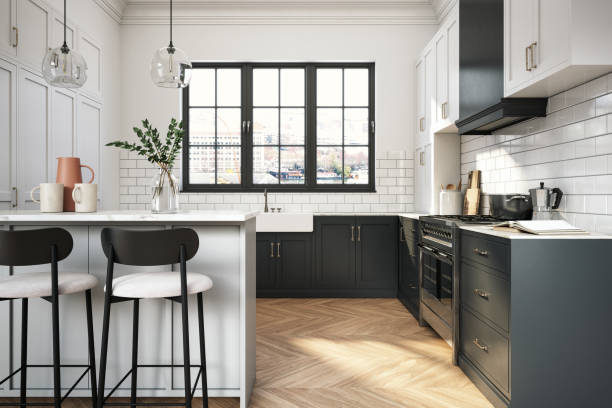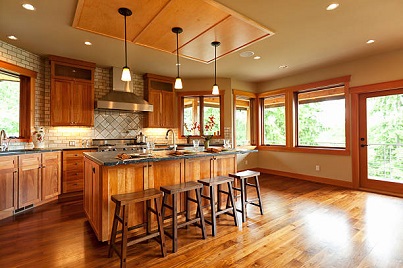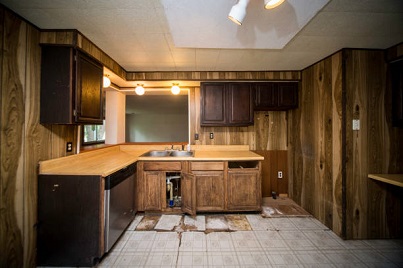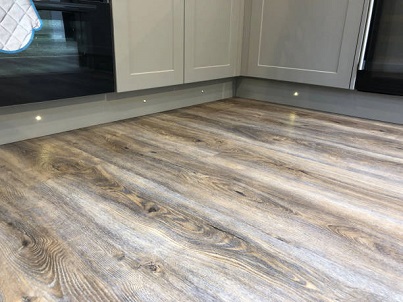by Liz Gonzales
Arguably, one of the most important rooms in your house when it comes to hygiene and food would be the kitchen.
It’s the place where you prepare your meals, clean your dishes, keep your cutlery and other tools for can-opening and making meatballs, as well as eating, in case you have a table large enough, of course. This is why keeping your kitchen as clean as a whistle is of utmost importance for the health and well-being of your family.
The trouble is, of course, that keeping a room with plenty of food scraps and large quantities of steam on a daily basis clean and sanitary can be somewhat of a challenge – especially if you don’t have the tools for the job. (the kitchen hood, chemical cleaning solutions, etc.)
While these you can get for a relatively small amount of money, a bigger concern would be the build of the kitchen itself. As you’re probably already aware, some materials deal better with steam and moisture than others, so when building up, or refurbishing your kitchen – paying attention to what materials you use can have long term benefits!
Contents
In this article, we’ll talk about kitchen flooring, in particular. A tough and water-resilient floor will be able to survive years of constant exposure to dirt, organic matter from food scraps, as well as copious amounts of steam on an everyday basis.
Right then, here are our suggestions on the topic of the best flooring types for your kitchen.

Even though it cannot really be described as the best flooring option for the areas of your home where there’s plenty of water and moisture, hardwood floors do come with plenty of benefits in return. And also, their well-known poor performance with moisture and steam is getting challenged nowadays thanks to some clever technological innovations.
Namely, the main problem with hardwood and water was that prolonged exposure would make the wood distorted and bloated, which would, over time, cause rotting and other problems such as accumulation of mold.
To tackle this, the designers of these floor materials have started incorporating some additional protective measures such as a polyurethane finish, for example. This additional coating doesn’t alter the appearance of the wood itself, but adds a layer of protection against moisture, which then pretty much resolves the problem of moisture!

For folks looking for an affordable, watertight flooring solution for their kitchen, laminate can be just the thing.
This versatile material has the shape-shifting capacity to be made to look like aged wood, ceramic tiles, porcelain – you name it. For this reason, it’s become incredibly popular with people who’d like to install certain types of flooring in their kitchen, but are too concerned about their lack of waterproofness, so to speak. (Also, materials such as hardwood and natural stone aren’t exactly the cheapest ones around.)
Add to that the fact that laminate is relatively easy to install and that it’s completely watertight, and you’ve got yourself a material that’s positively perfect for kitchens!

If you fancy flooring materials that feel soft and cushiony underneath your feet and are relatively resistant to water AND the tooth of time, cork may be the way to go for you.
Usually seen stuck on top of wine bottlenecks around the world, cork is a curious type of wood (or wood bark, to be more precise) that almost feels more like rubber than wood. Indeed, this material is malleable and manageable enough to be easily cut into whatever shape you so desire. Whether it’s penny-size tiles, hexagon tiles, sheets, or planks, you can get cork flooring in a wide variety of forms.
Another great thing about cork is that it represents a natural insulator, so if you install a cork-based floor in your kitchen, you can expect for the heating electricity bill to go down somewhat.

Representing one of the more exotic options on this list, bamboo is a material well known for its exceptional toughness. Not only that, it turns out that bamboo is a considerably better choice when it comes to water resistance – in comparison to regular wood that’s used for flooring.
A potential downside to bamboo, however, would be that, once you install it, refurbishing can be quite tricky. While ordinary wood usually has a clearly visible grain direction, bamboo doesn’t, so painting over it requires some special skills in order to pull off successfully. (To the point where you might be better off with just hiring someone to do it for you. Damaging once laid out bamboo will only create more expenses for you.)

Perhaps one of the most curious types of material for kitchen flooring in this article comes in the shape of linoleum – an invention of one Frederick Walton, who came up with this material way back in 1855 and subsequently improved it.
Made up of linseed oil, wood flour, finely ground cork dust, and some other mineral additives, linoleum is a durable and easy-to-install flooring perfect for domestic purposes. It’s the only drawback is that it can get completely ruined by prolonged exposure to water. To be fair, however, this is only in the case where the entire floor is submerged for an extended period of time.
Occasional spills such as dropping your soup on the floor or tipping over a glass of beer won’t create that much of a problem, though. So, unless you’re living in an area where there are frequent floods, you won’t have to avoid linoleum as an option for your kitchen floor.

If linoleum is an inexpensive and easy-to-use material for making kitchen floors, vinyl would certainly be right there sitting pretty side by side with it!
Whether we’re talking about water-resistance, ease of maintenance, or, indeed, longevity – you’ll see that vinyl is a sort of material that can serve you for years to come, while actually not requiring any additional means of maintenance along the way.
Indeed, all you need to do to make it ‘alive and well’ over the years is simply mop it regularly and make sure you don’t drop something scorching hot on it. Provided you take good care of it, vinyl-based kitchen floors can be used for years without the need for any additional expenses.
Plus, these floors cost peanuts!

Installing a bunch of carpet tiles as a flooring solution for your kitchen may not sound like the most brilliant idea of them all, but it may be more feasible than you think.
Namely, carpet tiles are a special breed of carpet-based flooring that you can use to cover your kitchen floor in whichever way you so desire. Since carpet tiles are usually small and come in a variety of shapes and sizes, you can arrange differently-covered tiles to make up patterns of your liking.
Also, if you’d like to change up the arrangement of these tiles after a while, this can be done much more easily than with other types of flooring!
(A quick note: When buying carpet tiles for your kitchen floor, make sure that you get the type that’s impervious to water. After all, you don’t want your kitchen to have a floor that will start stinking and housing mold the first time you spill some stew on it!)
As you can see, there are plenty of options for you to choose from when it comes to making flooring for your kitchen. Whether it’s vinyl, hardwood, linoleum, or some other form of flooring you fancy using, ensuring your kitchen is well-protected against stains and especially moisture by installing a watertight and durable flooring option is of utmost importance for the hygiene in your home.
Also, a well-placed quality flooring will be easy on the eyes and comfortable to walk on! What’s not to love?
 |
 |
 |
 |

About Liz Gonzales
Liz lives in a suburb in New York city.
Both of her parents are the art professors at Sate University of New York.
As such, Liz grew up with all kinds of art objects, portraits, and books laying around the home.
Liz met up with Linea through another friend in some kind of online art forum. There great minds sparkled to take their passions onto the next level @ linea.io.
 |
 |
 |
 |
You can Get FREE Gifts. Furthermore, Free Items here. Disable Ad Blocker to receive them all.
Once done, hit anything below
 |
 |
 |
 |